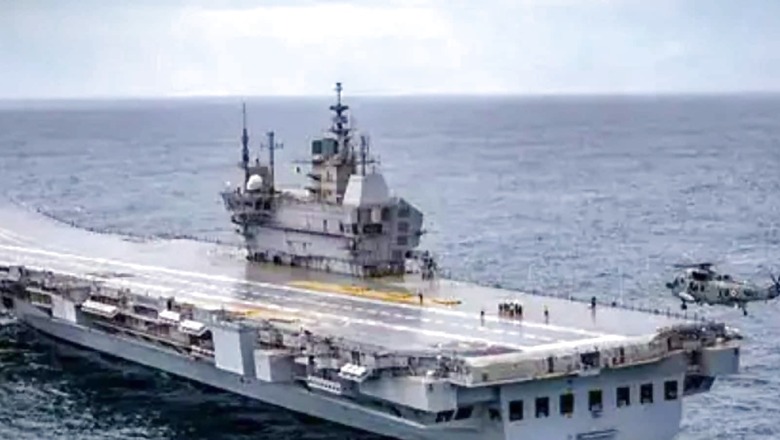
views
Majestic, gallant, victorious. INS Vikrant evokes many adjectives but none are perhaps adequate to describe the place this aircraft carrier will hold in our history. Vikrant is the second aircraft carrier that India commissioned after INS Vikramaditya. It is the first indigenously built carrier and carries the weight of its name. The original INS Vikrant, purchased from England in 1961, was decommissioned in 1997 after etching its name in gold in India’s maritime history. INS Vikrant played a huge role in the Indo-Pak war of 1971 leading to the liberation of Bangladesh.
The new INS Vikrant has been commissioned when China is flexing its muscles in the Indian Ocean Region and tension continues on both the Indo-Pak and Indo-China borders. Navy veterans like Group Captain UK Devnath have drawn attention to India’s strike capabilities getting enhanced because of Vikrant.
“If need be, with Vikrant we will be able to hit Karachi and the Gwadar port…all the way up to Madagascar, we will dominate the sea,” he said when asked about the impact of INS Vikrant on India’s maritime prowess. With India acquiring Rafale and looking closely at F18s, veterans feel that an aircraft carrier like Vikrant will allow the country to dominate thousands of kilometres and give a message to nations inimical to India’s interest.
The fact that India was without an aircraft carrier at the peak of tensions with China post Galwan also underlines the need for a second one. INS Vikramaditya has been undergoing maintenance and servicing for the past year and a half. Two carriers would not only allow alternate servicing but also ensure both the eastern and the western flanks of the country are covered.
Vikrant, once fuelled, can travel up to 7,500 nautical miles or for 45 days non-stop. In the words of Cochin Shipyard Limited’s (CSL) chairman and managing director (CMD) Madhu Nair, this could mean a trip all the way up to Brazil without refuelling. With talks of Rafale and F18 also coming on board along with the existing MiG 29Ks, that would give India dominance and assurance at sea in peace and adversity.
But amidst talks about muscle-flexing, and dominating, Prime Minister Narendra Modi emphasised that Vikrant is not just about India giving a message of rising power but also attempting to balance powers, especially in the Indian Ocean Region. Quoting former president APJ Abdul Kalam, he said, “Shakti aur shanti ek doosre ke liye zaruri hai (You need power for peace).”
As per navy veterans, as China tries to dominate the IOR, be it in Taiwan or Sri Lanka or Ladakh, Vikrant could help India reclaim the power equations in the region.
“60% of China’s fuel-carrying ships pass through the Strait of Malacca, from the IOR. China knows if it messes at Aksai Chin, it may have to pay for it…in terms of coastal access and security of its vessels,” Group Captain Devnath said.
India, however, is far behind as far as comparison with Chinese naval might is concerned. The Chinese navy has more warships and overall sea power. China ranks second on the Global Naval Powers Ranking 2022 after the United States, while India ranks seventh as per the World Directory of Modern Military Warships (2022).
China’s top aircraft carrier Fujian is of 80,000 tonnes displacement capacity while Vikrant is at about half, 42,800 tonnes. Shandong, the second Chinese aircraft carrier, is at 70,000 tonnes, while the third, Liaoning, can displace 58,000 tonnes of water. A fourth carrier is also in the works.
Captain Kamlesh Agnihotri (Retd), a senior fellow at the National Maritime Foundation (NMF), however, finds the comparison between Vikrant and Fujian unfair. He pointed out to CNBC that the mechanisms on the two ships are different. While INS Vikrant has a ski-jump kind of take-off mechanism, the Chinese Fujian has a catapult take-off.
“With catapult, you are able to launch heavier aircraft carrying more payloads, and more fuel, for longer range,” he said.
As far as numbers are concerned, the Indian Navy would ideally want the shipbuilding abilities harnessed during Vikrant to be immediately put to use for a third aircraft carrier. But after the Rs 20,000 crore expenditure on Vikrant, is India ready for another defence investment of this magnitude?
Read all the Latest News India and Breaking News here


















Comments
0 comment